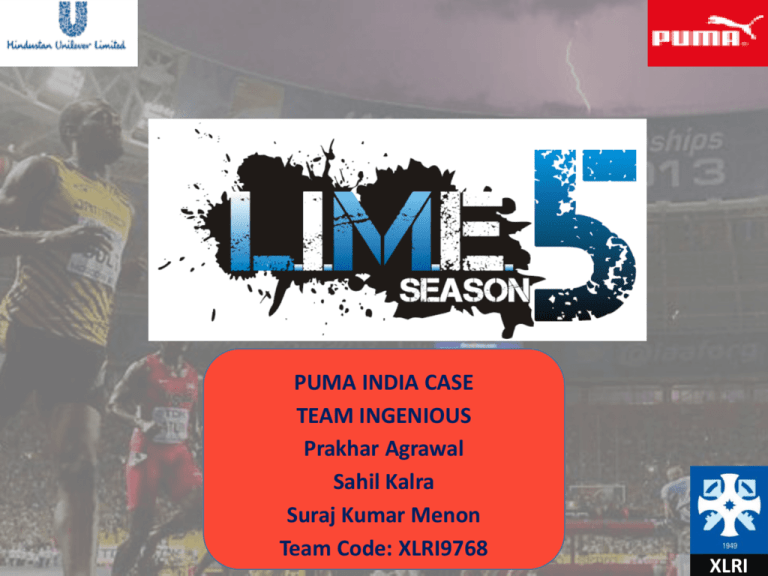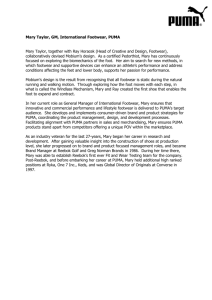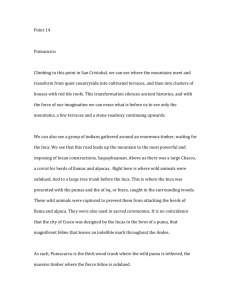LIME PUMA - Solutions @ Techshastra
advertisement

LIME PUMA PUMA INDIA CASE TEAM INGENIOUS Prakhar Agrawal Sahil Kalra Suraj Kumar Menon Team Code: XLRI9768 XLRI OUTLINE 1 Industry Overview- Indian Sportswear Market, PEST Analysis 2 Player Profiles (Nike, Adidas, Reebok, Puma) 3 Consumer Insights from Primary Research 4 SWOT Analysis for Puma 5 STP Analysis 6 Strategy for Penetrating the Target Market 2 OUTLINE 1 Industry Overview- Indian Sportswear Market, PEST Analysis 2 Player Profiles (Nike, Adidas, Reebok, Puma) 3 Consumer Insights from Primary Research 4 SWOT Analysis for Puma 5 STP Analysis 6 Strategy for Penetrating the Target Market 3 INDUSTRY OVERVIEW The sportswear market in India is largely unorganized with organized players constituting only around 30% of the market. Franchised exclusive brand outlets (EBO) and multi- brand outlets form the core retail channels for sportswear in India. Market segmentation Indian sportswear market 2010-2014 22.9 25 20 US$ bn 15 10 CAGR 33% Footwear 40% 7.3 60% 5 Apparel and Accessories 0 2010 2014 Source: Sportswear market in India, Ernst and Young India report 2012 Market size The sportswear market in India is estimated at Rs. 4000 crore. The Indian sportswear industry is poised for strong growth over the next few years and is expected to grow at a robust CAGR of 33% during 2010–2014. Several factors, including a booming middle-class population, a paradigm shift in consumer attitude toward health and fitness, an increase in the number of sports events and growth in organized retail are driving the market. Key segments The market includes sports apparel, footwear and accessories with footwear being the largest segment accounting for around 60% of the total market. 4 INDUSTRY OVERVIEW Indian sportswear market share Nike, 10% Others, 2% Puma, 18% *Other players include Fila, Lotto, Converse and New Balance COMPANY Bata Liberty Woodland Planet Sports Nike Inc Adidas AG Reebok International Ltd Puma AG Fila Lotto Sport Italia Rockport Kappa Skechers USA Inc Royal Sporting House (RSH) Organized sportswear market in India is dominated by the “big four”. Adidas, Reebok, Nike and Puma enjoy a 98% market share of the organized market with several others such as Fila and Lotto ramping up their presence. Nike was the first international player to enter the Indian market in 1994 through a licensing arrangement with Sierra Industrial Enterprises Pvt. Ltd. The company later established a wholly owned subsidiary in India in 2004. The retail landscape faces competition from multi-brand sportswear retailers such as Planet Sports and RSH. Domestic players such as Bata and Liberty also enjoy a considerable presence in the Indian market. Reebok, 45% Adidas, 25% APPAREL INDIAN O O INTERNATIONAL O O O O O O O O O FOOTWEAR O O O O O O O O O O O O O O ACCESSORIES O O O O O O O O O O Source: Sportswear market in India, Ernst and Young India report 2012 5 GROWTH DRIVERS Young Population in India • 464 • 430 Indian youth (in the age group 15 to 34 years) comprises over 34% of the total population. This is expected to cross over 464mn by 2021 and forms the core target group performance segment. Shift to Increasing Discretionary Spends 353 Non- Discretionary 2001 2011 2021 2019-20 Discretionary 50 2009-10 50 60 2000-01 40 70 30 Growing Middle Class in India Global Strikers Seekers 27 4 29 6 Increasing no. of sports events in India CAGR 21% • • • • CAGR 17% CAGR 12% 68 22 Aspirers CAGR 12% 75 93 Deprived 2021 2011 Indian Premier League Indian Hockey League Indian Badminton League Formula 1 CAGR (2%) 6 PEST ANALYSIS FOR RELEVANT FACTORS Political Economic VISUAL AWAKENING FDI in single brand retail raised from 51% to 100% , but with 30% local sourcing clause Former MD and CEO of Reebok India accused of a Rs. 870 crore fraud, leading to an acrimonious transfer of assets and stock sale Home market lobbying lead to cut in Excise duty on machineries for manufacturing from 7.5% to 5%, thus encouraging local manufacturing The Sportswear market is expected to grow at a rate of 33% in 2014 Growing middle class and its increasing Purchasing Power leading to strong demand for the category Recent rupee depreciation cutting margins since most of the products are imported Counterfeiting problem prevalent and bleeding the industry Consumer attitude and opinion changing in favour of branded shoes Upward shift observed in lifestyle trends and enhanced focus on fitness Recent success in Sporting Events leading to more youngsters going for professional coaching Advertising and Publicity efforts have bought the category into mainstream domain Breakthrough product innovations coming in the sector, enhancing comfort, agility and durability Buyers shifting towards E-Commerce websites for value deals Social media systems becoming increasingly popular for marketing to consumers Mobile platform being employed by players to reach out to the target segment Social Technology 7 OUTLINE 1 Industry Overview- Indian Sportswear Market, PEST Analysis 2 Player Profiles (Nike, Adidas, Reebok, Puma) 3 Consumer Insights from Primary Research 4 SWOT Analysis for Puma 5 STP Analysis 6 Strategy for Penetrating the Target Market 8 PLAYER PROFILE – NIKE Overview: Nike is the largest seller of athletic footwear and athletic apparel in the world. Nike India Pvt. Ltd. (NIPL) is a subsidiary of US-based Nike Inc., and was established in 2004 in India. Key brands: NIKE, Converse, LunarElite+ and Star Chevron Revenue: India’s contribution to Nike Inc.’s total worldwide revenues: NIPL generates 1% of the total revenues of the group. Manufacturing: In FY11, contract factories in India manufactured 2% of the total NIKE brand footwear. Nike also has manufacturing agreements with independent factories in India to manufacture footwear. Distribution: Nike sells its products to retail accounts, through NIKE-owned retail stores and internet sales under its “Direct to Consumer” operations, and through a mix of independent distributors and licensees, in over 170 countries around the world. NIKE in India Nike does not own any outlets in India. SSIPL is the master franchise of Nike in India Association with one of India’s most popular sport- Cricket: Nike has renewed its 5-year contract (US$590 million) with the Board of Cricket Control in India, to continue to be the official sponsor and apparel licensee for the Indian cricket team. Product innovation: Launched the "DriFIT" apparel technology containing 62% cotton, 34% polyester and 4% spandex, that has the capacity to contain sweating. Online retail: Partnered with online retailers such as Myntra and Bigshoebazaar to expand distribution beyond the conventional multi-brand outlets and large retailers. 9 PLAYER PROFILE- REEBOK AND ADIDAS Overview: Adidas and Reebok entered the Indian market in 1995. Reebok although owned by Adidas, runs as an independent entity. The companies sell a range of products including apparels, footwear and accessories. Key brands: Adidas has three brands in India, including the flagship brand, Reebok and TaylorMade. The latter targets the golfwear market, while Reebok and Adidas are known sportswear products. Distribution: The players leverage upon their combined retail distribution of 1,800 stores across all three tiers of consumers. – Adidas operates through 750 exclusive franchise outlets, and has opened 125 new exclusive outlets in 2011 to strengthen its presence in India. – Reebok has over 1,000 stores across 325 cities and towns in India. Joint Operating Model (JOM) Adidas and Reebok operate through a joint model in India. The two competing brands have established an agreement to not cannibalize the market share of each other, and aim to increase their joint share. Sports merchandising: Official sportswear partner for Force India, Reebok has dedicated a collection of apparel and accessories inspired by the Force India F1 team. Adidas opened up a ‘Core Concept store’ in Delhi, which carries an exclusive Sachin Tendulkar range, appealing to cricket fans. Innovation: Reebok have introduced new footwear such as “Realflex”, "Easytone" and "Zigtech. Reebok is working on a project to introduce a shoe priced at US$1 in rural markets. Online retail: Reebok (www.shop4reebok.com) has started their online shop in India Pricing: Reebok has adopted a pricing strategy to target both the premium and the lower-priced segment. However, 10 low-end products contribute significantly, comprising 70% of its sale volumes and 50% of its revenues. PLAYER PROFILE- PUMA Overview: Puma entered the Indian market in 2005, and has witnessed a CAGR of 40%–50% since 2006. Key brands: Puma Revenue: Puma have been growing at 50% y-o-y in India and is the number one brand in the country. Manufacturing: Puma products are manufactured both in India and abroad. However, all products are designed globally in Germany, London or Boston. – Footwear: Puma imports a majority of its footwear. It has however, localized its products to suit the tastes and preferences of the Indian consumers. Thus in 2007, it started manufacturing sandals, flip-flops and floaters in India. – Apparel: Apparel is manufactured locally, and a certain percentage is exported from India. – Accessories: Accessories are imported from abroad to maintain a low cost base. Distribution: The company has a strong distribution network with more than 165 exclusive outlets, approx. 200 large format stores, and over 500 dealer points in India. Sports sponsorship: In 2012, Puma tied up with tow IPL teams Sunrisers Hyderabad and Rajasthan Royals. It is also the official licensing partner for Ferrari and the supplier of team and race wear for Scuderia Ferrari Product portfolio: The company plans to introduce its perfumes in India in 2012 leveraging its exclusive manufacturing license with P&G. Online retail and marketing: In 2011, Puma launched PumaShop.in selling footwear, apparel and accessories. The company expects this ecommerce arm to contribute 10% of Puma India’s overall revenues by 2015. Nearly 40% of the company’s ad spend goes into digital media. 11 OUTLINE 1 Industry Overview- Indian Sportswear Market, PEST Analysis 2 Player Profiles (Nike, Adidas, Reebok, Puma) 3 Consumer Insights from Primary Research 4 SWOT Analysis for Puma 5 STP Analysis 6 Strategy for Penetrating the Target Market 12 RESEARCH METHODOLOGY AND FRAMEWORK 204 Respondents IN DEPTH INTERVIEWS SURVEY DATA 28 Respondents IDENTIFICATION OF KEY PURCHASE DRIVERS AND PARAMETERS MIND MAPS 31 INDIVIDUALS PERCEPTUAL MAPS PUMA BRAND PERCEPTION MULTI DIMENSIONAL SCALING INDIRECT COMPARISON OF BRAND PERCEPTION KEY COMPETITOR BRANDS ANALYSIS OF VARIANCE IDENTIFY GAPS IN CURRENT STP PERFORMANCE CATEGORY SPECIFIC TARGETING AND POSITIONING STRATEGIES CONSUMER AWARENESS BRAND RECALL & SHARE OF MIND USAGE PATTERNS & LIFESTYLE DATA PURCHASING HABITS AND INFORMATION SEARCH EXTERNAL ENVIRONMENT ANALYSIS + CATEGORY ANALYSIS PERFORMANCE SEGMENT DRIVERS RECOMMENDATIONS 13 CONSUMER INSIGHTS- ONE ON ONE INTERVIEWS Why do consumers purchase I am looking for a shoe that provides me comfort I need a shoe for exercise and rough use PURCHASE DRIVERS Buying a good shoe improves my workout experience What do consumers purchase I would prefer a branded shoe because it guarantees performance PRODUCT ATTRIBUTES I look for the latest trends I have owned the same shoe for the last five years I like to purchase the newest technology on the market CONSUMER INSIGHTS When do consumers purchase I buy shoes only once in two to three years Makes a dual statement- style and good performance I buy whenever there is a sale My usage is limited so I don’t buy new designs too often 14 CONSUMER INSIGHTS- ONE ON ONE INTERVIEWS How do consumers purchase I take advice from someone I trust I prefer to go the store and decide on the spot INFORMATION SEARCH Online information is often unreliable. What do consumers look for when purchasing I use these for long periods, it must be tough Changing brands has been a bad experience If a shoe is not comfortable it is annoying Where do consumers purchase I go only to showrooms I prefer buying at large stores because it gives me more choice I prefer trying on various shoes for myself PURCHASE DRIVERS I don’t mind paying a higher price as long as I get quality CHANNEL CHOICE I buy online because deals are better I usually buy from wherever is suggested to me 15 DEMOGRAPHICS AND OTHER KEY PARAMETERS FOR PRIMARY RESEARCH IN DEPTH INTERVIEWS: Students Gym members Gym Staff Housewives Professional Athletes MIND MAP STUDIES : Students Gym members & Staff Housewives Professional Athletes Female 21% KEY SURVEY DEMOGRAPHICS: Total survey respondents: 204 Further factored by: Age Gender Location Income (data not shown) 31-40 11% > 40 6% < 18 6% 19-24 29% 25-30 48% Male 79% International , 5.9 Tier III , 14.2 Metro , 53.4 Age in years < 18 19-24 25-30 31-40 > 40 Total 5.9 29.4 48.5 11.8 5.9 Male 2.9 26.5 38.2 7.4 2.9 Female 2.9 2.9 11.8 4.4 1.5 Tier II , 26.5 16 BRAND RECALL AND AWARENESS Aided recall for performance brands PUMA 6% WILLS LIFESTYLE 1% REEBOK 8% 100 100 100 98 ADIDAS 24% 91 91 57 44 55 NIKE 57% Others 4% Others ; 29% Puma ; 19% RESULTS FOR TOP OF THE MIND RECALL FOR SPORTS/PERFORMANCE BRANDS Nike ; 31% Reebok ; 12% Adidas ; 9% PATTERN OF CURRENTLY OWNED SPORTS/PERFORMANCE BRANDS AMONG SURVEY RESPONDENTS 17 AWARENESS ABOUT TECHNICAL FEATURES % Awareness for various technical features across brands 70.6 66.2 60.3 29.4 19.1 23.5 22.1 19.1 7.4 Mobium Zigtech LunarGlide FAAS Bioweb Clima Cool Boost Free AirMaxx KEY TAKEAWAYS: Poor top of the mind recall. High aided recall does not translate into purchase decision Awareness of Puma’s technical innovations is low 18 DECISION CRITERIA FOR PURCHASE PREFERENCES ITEM TOTAL SCORE 1 RANK Comfort 747 1 Technical Features 729 2 Looks 726 3 Brand 708 4 Durability 693 5 Price 681 6 1-Weighted rank sum of all scores. Weights assigned in decreasing order of rank via responses to a question where respondents ranked parameters in their order of preference. Scores calculated via Surveygizmo’s inbuilt analysis tool. Key Takeaway: Category driven largely by credence and experience attributes and not by search attributes 19 CONSUMER BEHAVIOUR ANALYSIS Buying channels for Sports/Performance wear 67.7 35.3 35.3 27.9 17.7 4.4 Exclusive showrooms Large retail stores Online Factory Outlets Specialised sports stores Others KEY TAKEAWAYS: Brand specific channels dominate Online channels small but rapidly growing Online is a high growth segment which cannot be neglected 20 PERCEPTUAL MAP Utilises multi distance scaling Respondents were asked to rate eight different brands on two parameters Technical superiority Looks and designs Participants provided a rating for each brand on these parameters on a scale of 1-100. The average scores obtained for the brands were plotted pairwise on a two by two axes with the intersection at (50,50) and distances determined to construct the perceptual map as shown in the following slide 21 PERCEPTUAL MAP FOR THE PERFORMANCE SPORTS INDUSTRY KEY TAKEAWAYS: High on looks and design Low on looks and design High on technical features Low on technical features Puma perceived largely only as a fashion brand. For Puma to achieve a status comparable to that of Nike and Adidas, requires a better perception of technical superiority 22 CONSUMER BEHAVIOUR ANALYSIS Information sources for guiding purchase decisions 54.4 51 32.4 26.5 19.1 11.8 4.4 Manufacturers advertisements Online forums Friends & Family Gym staff/trainers Professional athletes In store sales staff Healthcare professionals Key Takeaways: Category is driven by credence and experience attributes. Search attributes are often lower in importance 23 CONSUMER INSIGHTS- EXERCISE FREQUENCIES Others 11% Walking/Light Jogging 33% Gym/Fitness Training 22% Basketball 3% Football 7% Tennis 3% Running ( seriouss runners) 14% Cricket 8% Emerging trend of fitness consciousness and running among consumers-significant opportunity to specifically target this segment of the population through directed efforts 24 INSIGHTS FROM THE MIND MAPPING EXERCISE (REPRESENTATIVE) Low Mainstream Communication, Lack of Social Media Activity leading to Poor Visibility Brand Association with Running stronger than that with team sports Puma Sturdy Low Sales Won’t Buy Less Variety Bad Football shoes No Ads Known for its fashion Quotient Weak in colour perception Technological Strength doesn’t come out Poor Brand Strong Rivals Visibility Poor Puma Puma Shoes Tee Athletics Running Sports Running Metal Tee Usain Bolt Usain Bolt Basketball Football Jersey Michael Jordon Olympics Olympics Athletics Black Tendulkar Marathon Strength Party Price Ganguly Sprint Cricket Formals Material Drogba Casual jog Money Panther Fashion Puma Sports Fashion Brand footwear Style Flexible White Fancy Elegant Colours Durable Running Expensive Simplistic Different Lasting Elite Exclusive Logo showroom Cut Shape INDIVIDUAL BRANDS Vs IDEAL PROFILES Respondents were asked to rate their perception of the ideal sports/performance product as well as four individual brandsNike, Reebok, Adidas and Puma on a scale of 1 to 7 on the following parameters • • • • • • Price Durability Technological Features Brand Looks and Design Comfort The ratings were analysed by individual ANOVA followed by Tukeys HSD Test to determine the source of variation for each individual parameter 26 ANALYSIS OF VARIANCE- IDEAL vs OTHER BRANDS WHETHER STATISTICALLY SIGNIFICANTLY DIFFERENT FROM IDEAL NIKE PUMA REEBOK ADIDAS PRICE No No No No DURABILITY No Yes No No TECHNOLOGIC AL FEATURES No Yes No No LOOKS and DESIGN No No Yes No COMFORT No No No No BRAND No Yes Yes Yes Thus Nike and Adidas are seen to be closer to the ideal brand profile than Puma. The difference arises significantly from inputs on price, technological features and comfort as well as brand positioning 27 ANALYSIS OF VARIANCE- PUMA vs COMPETITOR BRANDS NIKE REEBOK ADIDAS PRICE Yes Yes Yes DURABILITY Yes Yes Yes TECHNOLOGICAL FEATURES Yes Yes Yes LOOKS and DESIGN No Yes No COMFORT No No No BRAND No Yes No Thus the overall perception of Puma differs significantly from that of Nike and Adidas on three main parameters: Price, Durability and Technological Features. 28 OUTLINE 1 Industry Overview- Indian Sportswear Market, PEST Analysis 2 Player Profiles (Nike, Adidas, Reebok, Puma) 3 Consumer Insights from Primary Research 4 SWOT Analysis for Puma 5 STP Analysis 6 Strategy for Penetrating the Target Market 29 SWOT ANALYSIS FOR PUMA’s Product and Marketing Strategies Strengths Strong positioning in Sports Lifestyle Category Products seen as trendy and fashionable- important criteria driving purchase decisions Widespread presence throughout the country – large store network and strong sales presence Poor association of brand with sports Weakness Marketing campaigns limited in scope and diffused Limited presence on social media compared to competitors Unable to communicate technical superiority effectively Efficient sourcing through WorldCat Growing running and gym culture across Metros and Tier 2 Indian cities Opportunities to leverage technical superiority for positioning in performance segments Positioned to leverage its partnership/affiliation with RFL and football clubs ( Arsenal) to expand presence in Indian market Opportunities Entry of several focused competitors into the performance segment such as Decathlon coupled with growing consumer awareness Susceptibility to economic fluctuations and sourcing variability Rival brands already have extensive foothold- can expand rapidly Threats 30 OUTLINE 1 Industry Overview- Indian Sportswear Market, PEST Analysis 2 Player Profiles (Nike, Adidas, Reebok, Puma) 3 Consumer Insights from Primary Research 4 SWOT Analysis for Puma 5 STP Analysis 6 Strategy for Penetrating the Target Market 31 SEGMENTATION ANALYSIS 13.2 12.9 11.6 12.6 10.2 7.6 Broadly Target A and B Class Urban consumers- 32.6% of Indian urban population 9.8 8.6 5.1 4.7 2.6 1.1 A1 A2 A3 B1 B2 C1 C2 D1 D2 E1 E2 E3 Population trends indicate that a larger bracket will fall into these categories in coming years increasing the size of the pie Current SEC Urban Classification ( adapted from the Marketing Whitebook 2013) 32 SEGMENTATION AND TARGETING Performance sportswear usage type linkage Emphasise style over health AGE GROUPS Balanc e style and health Exercise mainly for health benefits Serious athletes Consumer Profile School and college students- Large untapped market. Usually just starting out and undecided on brand EXPERIENCERS 13-22 years Late teenagers- Highly status conscious. Tend to be driven more by social acceptance than health. Prefer sports over other forms of exercise 21-25 years 25-40 Years STRIVERS Young professionals- seek exercise mainly for social benefits and less for health reasons Working Professionals- approaching middle age, seeking to maintain health and avoid lifestyle disorders. More likely to be affiliated with gyms. Also explore alternate health techniques such as yoga, aerobics etc. ACHIEVERS Homemakers – exercise as a social activity, prefer light forms of exercise such as walking, cardio in the gym Working professionals – tend to be highly health conscious. Awareness of lifestyle disorders is high >40 Years NA FULFILLEDS Retired- usually empty nesters. Seek mild to moderate forms of exercise NA 33 OUTLINE 1 Industry Overview- Indian Sportswear Market, PEST Analysis 2 Player Profiles (Nike, Adidas, Reebok, Puma) 3 Consumer Insights from Primary Research 4 SWOT Analysis for Puma 5 STP Analysis 6 Strategy for Penetrating the Target Market 34 MARKET STRATEGY Emphasize on Health and Fitness EXPAND MARKET SIZE Catch customers young, at schools Offer Innovative Pricing like EMI’s Loyalty Programs, Exchance Offers MARKET STRATEGY DEFEND MARKET SHARE Awareness about Technological brilliance Integrated Mass Media campaigns Product Line Extension-Fitness Accessories Exclusive Performance Outlets Digital Marketing ENHANCE MARKET SHARE Mobile Apps Tie ups with Gyms, Sports Clubs Corporate Assosciations 35 SEGMENT SPECIFIC POSITIONING STRATEGIES Marketing mix elements Experiencers Product: Design oriented, focus on technical attributes and style Price: Aggressive Promotion: Emphasis on youth, brand ambassadors Place: In school and college tie ups Strivers Product: Focus on trendy, style and design Price: Captive Pricing Promotion: Focus on trendy image, youth directed fun oriented campaigns Place: Tie up with gyms, running clubs Achievers Product: Focus on technical superiority and health benefits Price: Premium pricing Promotion: Integrated campaigns emphasising health benefits Place: Corporate tie-ups. Focus on premium channels and high end Fulfilleds Product: Health benefits and ease Price: Captive Pricing Promotion: Promote ‘wellness’ experience, endorsement by healthcare professionals Place: Customer centric, tie-ups with hospitals and medical practitioners 36 THE YOUTH SEGMENT- UNTAPPED POTENTIAL With Brand Association very strong in the category, it is very important to target the consumers young and engage with them to build Brand Loyalty and generate Word of Mouth Schools- Catch them Young Colleges- Engage, Build Loyalty Sponsor school teams at Reputed Schools in Metros and Tier 2 cities Sponsor College Sports Fests, distributing Footwear to Opinion leaders and encouraging sales by giving discount coupons Establish PUMA running academy to select, train and promote young running talent Engage with the target audience across various social media platforms like Facebook, Twitter etc by giving Fitness Tips Organize Sports Quizzes across Schools for a stronger brand association with sports Organize Leadership Series events where renowned Indian sportspersons interact with college students 37 PROMOTION STRATEGIES – MASS MEDIA It is important to counter the mass media blitz created by Nike through its Bleed Blue Campaign, Adidas through is ‘Impossible is Nothing’ campaign Tagline: Technology for Race PRODUCT PLACEMENT: In Sports based Movies to capture widespread attention of the target group Title Sponsorship: Bid for Title rights for tournaments for non-cricketing sports like Badminton, Tennis etc Brand Ambassador: Bring Usain Bolt to India for a promotion trip. Will help garner a lot of free media publicity 38 ATL Advertising-Key Message, Storyboards and Strategy Technology for the Race Yuvraj running on a mountain stretch He then shifts onto an Icy Landscape for running Yuvraj talks about the ease and comfort in running with the shoe in all terrains Focus shifts on highlighting the Technology gone into the shoe Brand Mobium highlighted as the ‘Shoe for the Human Race ‘ Message: PUMA’s shoes are high on Technology and provide comfort even in extreme running conditions Rationale to hire • Youth Icon , one of the most renowned non cricketing sportsperson • Olympic medalist, holds a lot of credibility Rationale to retain • World Cup Winner, in sync with our TG • Perceived as “manly” and sporty Untapped Brand Potential Exclusive association with PUMA Brand Ambassador Brand Ambassador SALES STRATEGIES Exclusive Performance Outlets • Designate some outlets in Metros as Exclusive for sports wear • They act as Experience Zones for consumers to get a feel of the product range and build awareness • Provide Fitness tips and make them as Touch Points for On-Ground Activation Programs Cross Selling • Bundle products based on usage, Ex: Cricket shoes with Cricket Bats • Leveraging the strength of a wide range of Sports Apparel Upselling Sales Force Training Gyms and Sports Clubs • Introduce EMI schemes for shoes above Rs. 5000 to expand the market • Rs. 500 discount on returning old branded shoes to poach customers from others and maintaining own brand loyalty • They should have adequately technical knowledge to handle customers who have good knowledge of the category • Survey results show that after family & friends, they are the most trusted source for information • Using coaches as opinion leaders to drive brand promotion • Ensuring Product Display and bulk buy incentives 40 DIGITAL MARKETING STRATEGY Puma- Technology for Race Tie up with Sports sites like Cricinfo, Goal.com to display adds and run contests during major sports events. • • • • • Currently Puma has only an international channel • Introduce a new Puma India Performance channel • Video share on running tips and unforgettable moments in sports history • 20 sec non-skippable Ads on Youtube videos to garner viewership of Target Segment • Do Search Engine Optimization to ensure that Puma appears when somebody searches for “Running Shoes” • Ensure visibility of latest performance wear on homepages of online retail website like Flipkart, Jabong, etc to drive purchases Strong need to increase number of likes/shares Get product testimonials/ product stories 5 users get a prize each week Lucky draw to distribute invites to party with Yuvraj Singh & Saina Nahiwal • Post Exclusive Advertisements • Post fitness tips Identify Alfa Influencers in the Target Group • Users who regularly post on the wall of FB page • Users who have a large group of friends • Users who are active on other platforms and have followers there (blogs/twitter) • Promoting products via non-monetary incentives such as giving products before launch for trials to such influencers & gather feedback Since, we aim to target the age group of 18-30, digital media is the most preferred form as an average youth spends more 41 time on the internet than any other communication medium available PROMOTION STRATEGY – MOBILE APP Smart Phone Penetration in India Calculates the distance run, time taken, speed and calories burnt Assigns “Bolt Score” to each run based on various parameters. Compete with friends and professional athletes - individually or in teams. Gives Purchase recommendations, nearest Puma store details, latest arrivals Share runs, achievements, leaderboard positions, purchases over social media Income Sec D Sec C Sec B RUN Sec A BOLT SCORE Age 4% 6% 8% 18% PUMA STORE Source: Nielsen Informate Mobile Insights Smartphone Adoption high in the age group of 18-30 On the lines of “Nike Fuel”, Puma can develop a smartphone app and a performance measurement unit of its own- “BOLT”. An iOS and Android running app. The same can help in • aiding recall of the brand • establishing Puma as a sports brand. • communicating new products and promotions. • suggest products to users based on performance patterns PROMOTION- IMPROVING ENGAGEMENT WITH RFL Improve engagements with local RFL Chapters through short term activations and one off events Combined PUMA sponsored teams for competitive running events including PUMA Urban Stampede Bundle RFL memberships with purchases of PUMA products Chain premia for RFL members- co branded PUMA card Long term Mentoring programs: By brand ambassadors for RFL chapters By RFL members for younger audiences Student version of Urban Stampede for schools and colleges in association with RFL Anu Vaidyanathan Shayamal Vallabhjee Girish Mallya 43 CASE SUMMARY Topic Insights and Strategy Industry Overview 4000 crore industry growing at a CAGR of 33%. Four Major Players- Reebok, Adidas, Nike, Puma share 98% of the market Growth Drivers: Increasing youth population, increasing discretionary spends, increasing number of sports events, growing middle class in India Player Profiles Nike: Leverages its strong association with Cricket and is known for both product technology and style Reebok: Once, the market leader, losing market share now due to damage in brand equity on account of financial fraud Adidas: Wide distribution, strong association with Sachin Tendulkar, manages Reebok too so looks to avoid cannibalization Puma: Known more for style quotient than technology, has lifestyle product image, growing strongly in the segment Expand Market Strategy Poor top of the mind recall, awareness of Puma’s technical innovations is low, perceived as a fashion brand Technology and Comfort are category drivers, sales driven through exclusive outlets though online sales are growing well Trend of fitness consciousness increase in running, friends & family and sales staff are important influencers Children, professionals living in Metro, Tier-2 cities are the target segments Target schools and colleges to catch them young, sell shoes on EMI’s to rise over price hurdle Emphasize more on Health and Fitness to increase the category size Brand association with Energy Drinks to create a sports related positioning Defend Consumer Insights Design loyalty programs, promulgate exchange offers to generate repeat purchase Raise awareness about technical brilliance of the products as that is not getting conveyed to the customers Run integrated Mass Media campaign to target the ideal segment so as to build Top of the Mind Recall Go for product line extensions in fitness accessories to capture incremental sales Enhance SWOT Strength: Strong positioning in Sports Lifestyle Category, widespread sales network Weakness: Poor association with sports, low digital presence, inability to communicate technical superiority Opportunity: Growing running and gym culture, potential tie ups with EPL to boost brand association Threat: Entry of focused brands, economical fluctuations, others have larger distribution network Launch Exclusive Performance stores in metros to generate awareness, use them as touch-point for activations Digital Media campaign to bridge gap with competitors and reach out to TG, mobile Apps for more engagement Tie ups with Gyms to launch Puma Fitness Zones for providing health and fitness tips Collaboration with corporates through running initiatives to build long term relationship 44 Thank You 45






